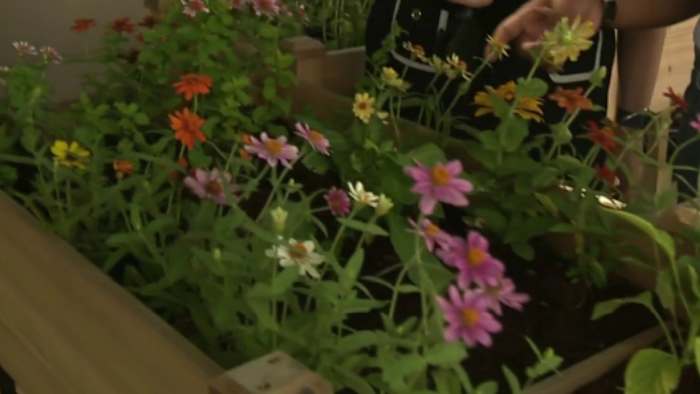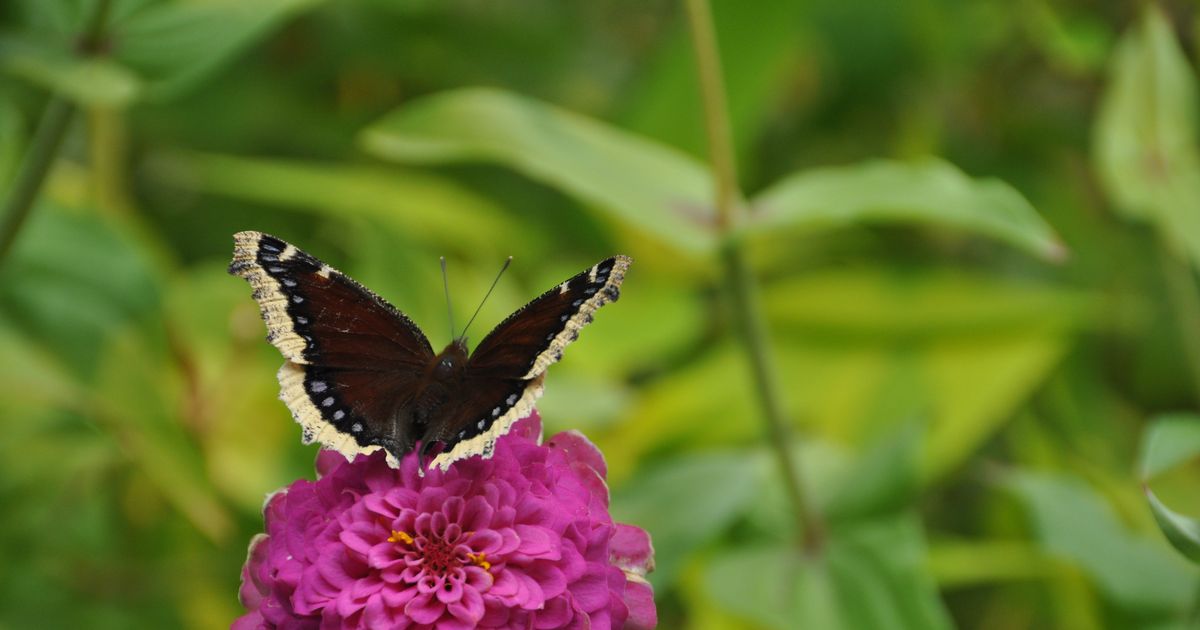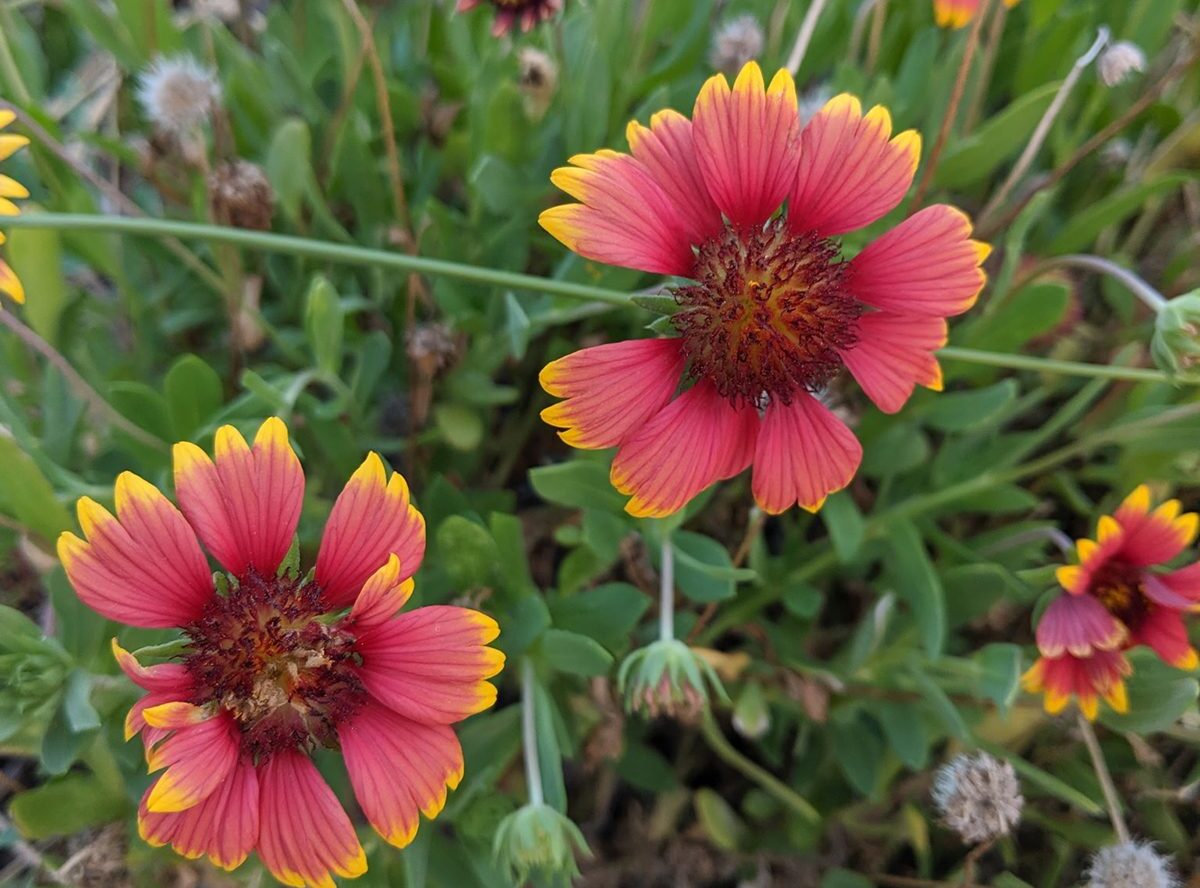Adam Kemp
PBS News
As he peels back the husk of corn grown in his garden, Miko Brandon reveals deep red kernels hiding underneath.
Brandon knows that unlike yellow and white varieties, this Chickasaw red corn will have a sweet but nutty flavor to it when cooked or made into cornmeal or bread. He has dreams of using it to cook up a feast for his family and friends in Tishomingo, Oklahoma.
Brandon said the idea of homesteading and being self-sufficient has always been of interest to him. Growing up as a citizen of the Chickasaw Nation on his family plot of land, there were barns for livestock, pens full of hogs, and a hut for drying large quantities of corn. The foundation of the house is still tied together by Bois d’Arc tree stumps.
But as he got older, some of these practices fell away or became too hard to maintain. In 2019, after returning from serving in the U.S. Navy as an aircraft engine mechanic, Brandon said he was compelled to start his family garden again.
“I just thought, ‘Man, we need to invest in this land again,’” Brandon said. “That’s when we started growing.”
Climate change has threatened Indigenous communities’ access to traditional foods, such as fish, game, and wild and cultivated crops — resources that have provided sustenance and cultural, economic, medicinal, and community health for generations. Unpredictable precipitation patterns, rising temperatures and more frequent extreme weather events are threatening Native American agriculture systems more broadly, including the supply of traditional foods and crop growth, according to a 2023 study from the U.S. Global Change Research Program.
Many Native American communities are bearing the brunt of climate change in the U.S., says Kyle Whyte, professor of environment and sustainability at the University of Michigan and an enrolled citizen of the Citizen Potawatomi Nation.
“It’s not just that Indigenous people are in the wrong place at the wrong time,” he said. “The source of climate change vulnerability is that racism, colonialism and capitalism have rendered tribes in a land situation where there is not a lot of options to adapt.”
“There’s a lack of resources and institutional support and a lack of consultation and coordination with all levels of government,” he said.
Perhaps the most significant effect climate change has had on tribal nations across North America is on food and water, said Paulette Blanchard, a citizen of the Absentee Shawnee Tribe and Kickapoo descendant who studies climate change effects on Indigenous communities for the Haskell Foundation.
Blanchard said food and water systems across the U.S. have been interrupted by severe weather tied to climate change including unpredictable weather patterns, drought, wildfires and tornadoes. In Oklahoma especially, she said, water aquifers and wells have been poisoned by man-made problems too, specifically the state’s long history with the oil and natural gas industry.
“It’s hard to count on or trust the weather patterns anymore,” Blanchard said. “And these severe weather events usually leave tribes have to pick up the pieces and help each other out.”
Brandon, 28, is studying environmental science at Oklahoma State University while also working as Watershed Fire Ecology Planner for the Chickasaw Nation, where he is an enrolled citizen.
His family’s home sits on the same plot of land his family has called home for more than six generations. The Blue River, known for its abundance of rainbow trout and bass, runs right through the heart of their land, keeping the soil healthy and fertile, which allows Brandon to nurture the small garden just off the house into a vibrant homage to his ancestral heritage.
In addition to the Chickasaw red corn, Brandon has grown Seminole pumpkins, Wichita squash, Anasazi beans, okra, tomatoes, cucumbers and wildflowers to attract pollinators.
It’s a small garden, but Brandon believes it could represent a unique intersection of his identity, sustainable and healthy living and an appreciation for nature.
“This is my passion and what I want to do,” Brandon said. “I want to help people through protecting and educating them about the environment. I think you gain a deeper understanding of the value of our land when you help cultivate it.”
Members of the Cherokee Nation Medicine Keepers meet with a group of students to teach them about gathering plants to craft food and medicine. (Photo courtesy of the Cherokee Nation)
Native-led solutions
The government’s Fifth National Climate Assessment, focused on climate change felt at the local level and released in November, detailed how the vulnerability of tribes to climate change today can be attributed significantly to the U.S. government’s historical displacement of Indigenous lands.
The report found that 182 federally recognized tribes in the Southwest contend with drought and elevated temperatures, adversely affecting livestock and agriculture. Across the Pacific Northwest, the Confederated Tribes of the Umatilla Indian Reservation reported that climate change poses a threat to their traditional subsistence practices, including huckleberry gathering, elk and deer hunting and salmon fishing.
Louisiana faces a submersion of tribal lands due to a combination of sea level rise and land erosion. Meanwhile, in Alaska, the thawing of permafrost — on an estimated 85 percent of the land — and rising sea levels have led to the displacement of Alaska Natives.
Blanchard said Native and Indigenous people are taking the lead on protecting land and traditions by using ancient adaptation practices, such as prescribed burnings to prevent wildfires, investing in renewable energy projects, and engaging young people to teach them about climate change.
Blanchard said it’s a remarkable moment because for the first time in history, Western science is beginning to work with Indigenous scientists to understand the relationship of plants and ecosystems, and the snowball effect the loss of one species can have on another.
“We don’t look at the world as resources we can extract,” she said. “We look at them as relatives that we have to have a relationship with. Western science “has a hard time of looking at inanimate objects as alive with personality and characteristics.”
“Indigenous people have always had a relationship with place. These are not resources, these are our relatives and we need to have relationships as such.”
Brandon said he’s encouraged others in his community to start their own home gardens and to keep traditional food-growing practices alive. His concerns about climate change extend beyond the reach of his own home. He worries that climate change is killing off the plants and materials found in nature.
“Our ability to go out into the woods or out into some of these old pastures to harvest some of these plants that aren’t grown in a garden,” Brandon said. “Those are the plants that I worry about first and foremost.”
As part of a recent partnership between the Cherokee Nation and the National Park System, the Cherokee Nation has designated a 1,000-acre area adjacent to the Buffalo National River in Arkansas for cultivation and study. The area is abundant with plants and natural resources of significant historical value to tribal traditions and culture. This initiative allows selected tribal members to cultivate these plants and subsequently transplant them to Oklahoma.
These members will be able to collect an array of culturally significant plants — wild indigo, river cane, wild onion, hickory, bloodroot and sage — that are essential to Cherokee Medicine Keepers for soothing ailments, producing nourishing food and craft materials.
Ryan Mackey, 47, has been able to visit Buffalo National River firsthand to scout the area. He said members of the Medicine Keepers have taken the process slowly, treating the resources from the area with extra care as they know how precious these materials are becoming.
“These plants are sacred,” Mackey said. “They are not just valuable, they are of spiritual significance and intellectual significance. When you are out there and you see all these plants that have such a big part of your ancestral history all sitting there together, it’s like coming home.”
Mackey said many of these plants are becoming increasingly hard to find in Oklahoma. While the Cherokee reservation is more than 7,000 square miles in northeastern Oklahoma, the reality is that much of it is now private land and homes, and it’s not possible for the Medicine Keepers to search all of it.
At the Buffalo National River Preserve, the plants are practically untouched and unspoiled due to a lack of human contact, resulting in bigger and more vibrant clusters.
Mackey said older members of the Medicine Keepers tell stories about how clusters of plants like that used to be abundant around the reservation.
The loss of plants “dovetails with climate change,” Mackey said. “The plants take care of us. We have a relationship with these plants and the way we use them and take care of them and harvest them.” Elders say this process strengthens the population, Mackey added.
The Cherokee Nation also has a seed bank program that allows citizens to request packets of seeds for dozens of varieties of plants and vegetables, including Cherokee pumpkin, Georgia Candy Roaster squash, several varieties of corn, medicinal plants and tobacco.
Cherokee Nation opened up requests earlier this month through an online portal system. Within four hours, the program had sold out of the 10,000 packets of seeds.
Christina Justice, the nation’s secretary of natural resources, said the demand has never been higher.
“It serves a need and a desire for our citizens to engage in their culture,” she said. “I think Cherokee people have gone to such great lengths to make these seeds accessible to our tribal citizens, (the program) gives them a connection to their past and everybody is just striving for that connection.
Mackey said he envisions a day when Cherokee Nation citizens can have their own gardens growing outside their homes, filled with fresh fruits and vegetables and medicinal plants to use on the spot. Despite the challenges of climate change, Mackey said Cherokee people will continue to push for this.
“We don’t look to the eventuality of [Earth’s] demise,” he said. “But we see this as a pivot point. It’s time for us to do something. The way things are evolving and progressing are not in the favor of our traditions and not in the favor of these plant varieties and populations, so we are putting our heads together not only for our children and grandchildren, but for the plants themselves. We believe it’s our responsibility to make that happen.”
For Brandon, his family is on his mind while tending to the long tendrils of Seminole pumpkins or examining the Wichita squash sprawled across the soil of his family’s land.
In Oklahoma, where 1 in 3 adults lives with Type 2 diabetes or prediabetes, according to research from the University of Oklahoma, Brandon knows the importance of healthy and fresh food.
His grandfather lost his eyesight and toes on one foot from complications of diabetes. An uncle lost a leg.
“If you go to rural towns, you’ll be lucky if you see a Dollar General,” Brandon said. “There’s not a ton of options.”
Brandon said he’s unsure whether his small garden can be a solution to such a large problem. Right now what he grows is enough to boost other meals for him and his family. There’s beans to add to chili, and corn and squash for side dishes.
He has visions of a community approach — people growing, people cultivating and people that can cook.
It’ll be hard work, Brandon said, but it’s already given him a new appreciation for his ancestors, the food and the Earth itself.
“It takes a lot of dedication,” he said. “But the reward is so great too.”
Sky Vazquez of ICT contributed to this story.
This story was produced as part of a partnership between ICT and the PBS NewsHour to cover how climate change is affecting Indigenous communities, funded with a major grant from the National Science Foundation.
Miko Brandon serves as a climate advisor for ICT under the grant.










